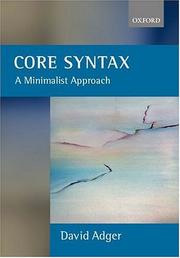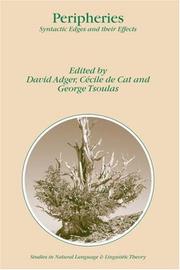| Listing 1 - 10 of 14 | << page >> |
Sort by
|

ISBN: 0199243700 9780199243709 Year: 2003 Publisher: Oxford : Oxford university press,
Abstract | Keywords | Export | Availability | Bookmark
 Loading...
Loading...Choose an application
- Reference Manager
- EndNote
- RefWorks (Direct export to RefWorks)
801.56 --- Grammar, Comparative and general --- -Minimalist theory (Linguistics) --- Generative grammar --- Comparative grammar --- Grammar --- Grammar, Philosophical --- Grammar, Universal --- Language and languages --- Philosophical grammar --- Linguistics --- Philology --- 801.56 Syntaxis. Semantiek --- Syntaxis. Semantiek --- Syntax --- Grammar, Comparative --- Minimalisme (Linguistique) --- Minimalist theory (Linguistics) --- Syntax. --- Minimalist theory (Linguistics). --- Syntaxe --- Grammar, Comparative and general - Syntax. --- Grammar, Comparative and general Syntax
Book
ISBN: 1283938863 0262312239 9780262312233 9780262018616 0262018616 9780262518307 0262518309 9781283938860 Year: 2013 Publisher: Cambridge, MA
Abstract | Keywords | Export | Availability | Bookmark
 Loading...
Loading...Choose an application
- Reference Manager
- EndNote
- RefWorks (Direct export to RefWorks)
Adger proposes a new approach to phrase structure that eschews functional heads and labels structures exocentrically. The proposal simultaneously simplifies the syntactic system and restricts the range of possible structures, ruling out the ubiquitous (remnant) roll-up derivations and forcing a separation of arguments from their apparent heads. This new system has a number of empirical consequences, which the book explores in the domain of relational nominals across different language families, including Germanic, Romance, Celtic, Polynesian, and Semitic.
Grammar, Comparative and general -- Syntax. --- Phrase structure grammar. --- Semantics. --- Phrase structure grammar --- Grammar, Comparative and general --- Semantics --- Languages & Literatures --- Philology & Linguistics --- Syntax --- Formal semantics --- Semasiology --- Semiology (Semantics) --- Comparative grammar --- Grammar --- Grammar, Philosophical --- Grammar, Universal --- Language and languages --- Philosophical grammar --- Constituent structure grammar --- Grammar, Phrase structure --- Grammar, Comparative --- Comparative linguistics --- Information theory --- Lexicology --- Meaning (Psychology) --- Linguistics --- Philology --- Generative grammar --- Syntax. --- LINGUISTICS & LANGUAGE/General --- Grammar, Comparative and general Syntax
Book
ISBN: 9780198828099 0198828098 Year: 2019 Publisher: Oxford Oxford University Press
Abstract | Keywords | Export | Availability | Bookmark
 Loading...
Loading...Choose an application
- Reference Manager
- EndNote
- RefWorks (Direct export to RefWorks)
All humans, but no other species, have the capacity to create and understand language. It provides structure to our thoughts, allowing us to plan, communicate, and create new ideas, without limit. Yet we have only finite experiences, and our languages have finite stores of words. Where does our linguistic creativity come from? How does the endless scope of language emerge from our limited selves?0Drawing on research from neuroscience, psychology, and linguistics, David Adger takes the reader on a journey to the hidden structure behind all we say (or sign) and understand. Along the way you'll meet children who created language out of almost nothing, and find out how new languages emerge using structures found in languages spoken continents away. David Adger will show you how the more than 7000 languages in the world appear to obey the same deep scientific laws, how to invent a language0that breaks these, and how our brains go crazy when we try to learn languages that just aren't possible. You'll discover why rats are better than we are at picking up certain language patterns, why apes are far worse at others, and how artificial intelligences, such as those behind Alexa and Siri, understand language in a very un-human way. 0Language Unlimited explores the many mysteries about our capacity for language and reveals the source of its endless creativity.
Creativity (Linguistics). --- Language and languages --- Philosophy. --- Linguistics --- Creativity (Linguistics) --- Creative ability (Linguistics) --- Linguistic creativity --- Competence and performance (Linguistics) --- Psycholinguistics --- Philosophy
Book
ISBN: 9780192843067 Year: 2021 Publisher: Oxford Oxford University Press
Abstract | Keywords | Export | Availability | Bookmark
 Loading...
Loading...Choose an application
- Reference Manager
- EndNote
- RefWorks (Direct export to RefWorks)
"All humans, but no other species, have the capacity to create and understand language. It provides structure to our thoughts, allowing us to plan, communicate, and create new ideas, without limit. Yet we have only finite experiences, and our languages have finite stores of words. Where does our linguistic creativity come from? How does the endless scope of language emerge from our limited selves? Drawing on research from neuroscience, psychology, and linguistics, David Adger takes the reader on a journey to the hidden structure behind all we say (or sign) and understand. Along the way you'll meet children who created language out of almost nothing, and find out how new languages emerge using structures found in languages spoken continents away. David Adger will show you how the more than 7000 languages in the world appear to obey the same deep scientific laws, how to invent a language that breaks them, and how our brains go crazy when we try to learn languages that just aren't possible. You'll discover why rats are better than we are at picking up certain language patterns, why apes are far worse at others, and how artificial intelligences, such as those behind Alexa and Siri, understand language in a very un-human way. Language Unlimited explores the many mysteries about our capacity for language and reveals the source of its endless creativity" --
Creativity (Linguistics) --- Language and languages --- Philosophy

ISBN: 1402019084 1402019106 1402019092 Year: 2004 Volume: 59 Publisher: Dordrecht ; Boston ; London Kluwer Academic Publishers
Abstract | Keywords | Export | Availability | Bookmark
 Loading...
Loading...Choose an application
- Reference Manager
- EndNote
- RefWorks (Direct export to RefWorks)
Grammar, Comparative and general --- Syntax. --- Electronic books. -- local. --- Grammar, Comparative and general -- Syntax. --- Linguistics. --- 801.56 --- 801.56 Syntaxis. Semantiek --- Syntaxis. Semantiek --- Language and languages --- Syntax --- Linguistics --- Philology --- Grammar, Comparative and general Syntax
Book
ISBN: 9780199213764 0199213763 9780199213771 0199213771 0191526738 1281528986 143567359X 9780191526732 9781281528988 9786611528980 6611528989 1383035237 Year: 2008 Volume: 16 Publisher: Oxford New York Oxford University Press
Abstract | Keywords | Export | Availability | Bookmark
 Loading...
Loading...Choose an application
- Reference Manager
- EndNote
- RefWorks (Direct export to RefWorks)
This title brings together the different strands and styles of research on Phi-features, such as person, number, and gender. It presents the core questions, major results, and new directions of this emergent area of linguistic theory and shows how Phi Theory casts light on the nature of interfaces and the structure of the grammar.
Grammar, Comparative and general --- Generative grammar --- Generative grammar. --- Grammar, Comparative and general. --- Comparative grammar --- Grammar --- Grammar, Philosophical --- Grammar, Universal --- Language and languages --- Philosophical grammar --- Linguistics --- Philology --- Grammar, Generative --- Grammar, Transformational --- Grammar, Transformational generative --- Transformational generative grammar --- Transformational grammar --- Psycholinguistics --- Grammar, Comparative --- Derivation
Book
ISBN: 9780521517560 0521517567 9780511657375 9781107403598 9780511658198 0511658192 1107191408 1107403596 9786612402456 0511656335 0511655487 0511656882 0511657374 Year: 2009 Publisher: Cambridge New York Cambridge University Press
Abstract | Keywords | Export | Availability | Bookmark
 Loading...
Loading...Choose an application
- Reference Manager
- EndNote
- RefWorks (Direct export to RefWorks)
What is the nature of syntactic structure? Why do some languages have radically free word order ('nonconfigurationality')? Do parameters vary independently (the micro-view) or can they co-vary en masse (the macro-view)? Mirrors and Microparameters examines these questions by looking beyond the definitional criterion of nonconfigurationality - that arguments may be freely ordered, omitted, and split. Drawing on data from Kiowa, a member of the largely undescribed Kiowa-Tanoan language family, the book reveals that classically nonconfigurational languages can nonetheless exhibit robustly configurational effects. Reconciling the cooccurrence of such freedom with such rigidity has major implications for the Principles and Parameters program. This approach to nonconfigurational languages challenges widespread assumptions of linguistic theory and throws light on the syntactic structures, ordering principles, and nature of parametrization that comprise Universal Grammar.
Grammar --- North and Central American indian languages --- Grammar, Comparative and general --- Kiowa language --- Cáuijogà language --- Kayowe language --- Kiaway language --- Kiowan language --- Manrhoat language --- Tepda language --- Tepkinago language --- Tanoan languages --- Language and languages --- Syntax --- Syntax. --- Arts and Humanities --- Language & Linguistics --- Linguistics --- Philology --- Grammar, Comparative and general Syntax
Book
Year: 1999 Publisher: Oxford Oxford University Press
Abstract | Keywords | Export | Availability | Bookmark
 Loading...
Loading...Choose an application
- Reference Manager
- EndNote
- RefWorks (Direct export to RefWorks)
Book
Year: 2004 Publisher: Dordrecht : Springer Netherlands : Imprint: Springer,
Abstract | Keywords | Export | Availability | Bookmark
 Loading...
Loading...Choose an application
- Reference Manager
- EndNote
- RefWorks (Direct export to RefWorks)
The syntactic periphery has become one of the most important areas of research in syntactic theory in recent years, due to the emergence of new research programmes initiated by Rizzi, Kayne and Chomsky. However research has concentrated on the empirical nature of clausal peripheries. The purpose of this volume is to explore the question of whether the notion of periphery has any real theoretical bite. An important consensus emerging from the volume is that the edges of certain syntactic expressions appear to be the locus of the connection between phrase structure, prosody, and information structure. This volume contains 16 papers by researchers in this area. The book: - contains an extensive introduction setting out the research questions addressed and setting the contributions in an overall theoretical context, - has a distinct comparative slant, - brings together work from a range of theoretical perspectives, while maintaining a unity of purpose, - could serve as the basis for a graduate course on peripheral positions, - contains papers addressing: = the question of the fine-grainedness of syntactic representations, = the relevance of syntactic edges to locality and semantic interpretation, = the nature of the dependencies connecting peripheral elements to the syntactic core. Audience: Academics and graduate students interested in syntax and its interfaces with semantics and prosody, acquisition of syntax, cross-linguistic comparison.
Linguistics. --- Comparative linguistics. --- Grammar, Comparative and general --- Theoretical Linguistics / Grammar. --- Comparative Linguistics. --- Syntax.
Book
Year: 2004 Publisher: Dordrecht : Springer Netherlands : Imprint: Springer,
Abstract | Keywords | Export | Availability | Bookmark
 Loading...
Loading...Choose an application
- Reference Manager
- EndNote
- RefWorks (Direct export to RefWorks)
The syntactic periphery has become one of the most important areas of research in syntactic theory in recent years, due to the emergence of new research programmes initiated by Rizzi, Kayne and Chomsky. However research has concentrated on the empirical nature of clausal peripheries. The purpose of this volume is to explore the question of whether the notion of periphery has any real theoretical bite. An important consensus emerging from the volume is that the edges of certain syntactic expressions appear to be the locus of the connection between phrase structure, prosody, and information structure. This volume contains 16 papers by researchers in this area. The book: - contains an extensive introduction setting out the research questions addressed and setting the contributions in an overall theoretical context, - has a distinct comparative slant, - brings together work from a range of theoretical perspectives, while maintaining a unity of purpose, - could serve as the basis for a graduate course on peripheral positions, - contains papers addressing: = the question of the fine-grainedness of syntactic representations, = the relevance of syntactic edges to locality and semantic interpretation, = the nature of the dependencies connecting peripheral elements to the syntactic core. Audience: Academics and graduate students interested in syntax and its interfaces with semantics and prosody, acquisition of syntax, cross-linguistic comparison.
Linguistics. --- Comparative linguistics. --- Grammar, Comparative and general --- Theoretical Linguistics / Grammar. --- Comparative Linguistics. --- Syntax.
| Listing 1 - 10 of 14 | << page >> |
Sort by
|

 Search
Search Feedback
Feedback About UniCat
About UniCat  Help
Help News
News